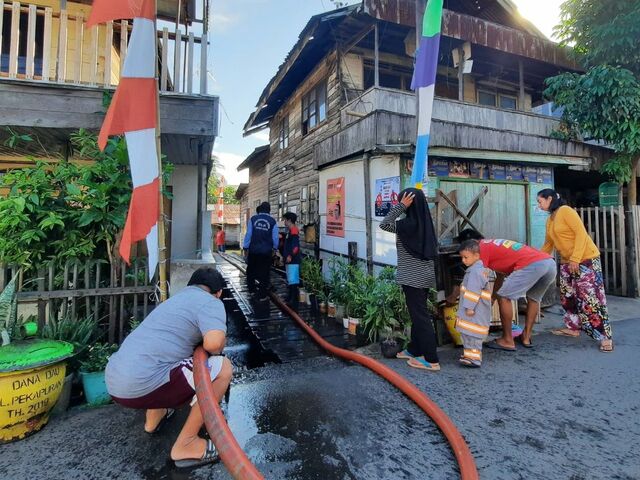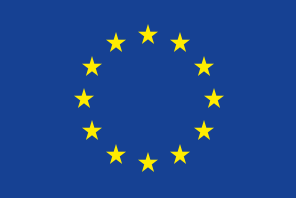Known as the “City of a Thousand Rivers”. Banjarmasin is one of the cities in Indonesia that is traversed by several rivers. Long ago, the people employed huge boats such as kelotoks and jukungs as their primary mode of transportation and trading along the river. As commerce occurs along the river, sometimes better known as floating marketplaces, the river serves as a supply of water used for everyday living and livelihoods.
For a long time, the river has traditionally been utilised by the people of Banjarmasin City for daily activities, including transportation, washing, fishing, and even bathing. However, now the function of the river has begun to shift. These activities still exist but are exceedingly uncommon due to the quality of river water which has significantly decreased. Meanwhile, the river’s increasing narrowness has made transportation increasingly challenging. Additionally, there are still people who throw garbage and waste into rivers which contributes to the accumulation or buildup of garbage in rivers.
To restore the river to its original, or at least its cleanliness, the Banjarmasin City Environmental Agency held a “Maharagu Sungai” competition. This competition was held in each sub-district. As a result, the rivers are beginning to clean up. In the long term, the rivers in Banjarmasin City will become even cleaner as the competition goes on.
A clean and comfortable river can also create a healthy environment for the people of Banjarmasin. To achieve this goal, community participation is needed in the program launched by the government, so the Banjarmasin City Government has made various efforts, especially through the Maharagu Sungai program, which is one of the strategies of the environmental communication campaign carried out by the Banjarmasin City Environment Agency to increase community participation in the river revitalisation program.
The Banjarmasin City Environmental Agency initatied the “Maharagu Sungai” evironmental participatory campaign after realising that the river is a crucial aset for the sustainability of Banjarmasin city in terms of investment, tourist destinations, and environmental health. This programme was created as cutting-edge in environmental communication activities carried out by the Banjarmasin City Government to encourage community participation along the riverbanks.
Banjarmasin City’s Department of Environment and Forestry (DLH) has also come to the realisation that it will be very difficult to realise the vision and mission of Banjarmasin BAIMAN “barasih wan nyaman” or clean and comfortable in Indonesian, if only the government side moves without the support and contribution of the surrounding community.
When it comes to the meaning of the word 'Maharagu' in Maharagu Sungai in Indonesian translates as ‘nurturing’ or ‘guarding’. The competition aims to revive the life of several rivers in Banjarmasin City that appear dead because they are shallow and impassable due to piles of garbage and household waste that accumulate at the bottom of the river.

Maharagu Sungai consists of three stages of action: first, when a river leader is selected, a group is formed by enlisting those who care and share their concern for the river. Second, the community is mobilised to clean up the by river stakeholders and their organisations. A sense of urgency is brought up as when their friends clean the river, but they pollute it once more, a moral dilemma will ensure. At this stage, the competition score will improve with further participation by more people. The third is creativity as they are welcome to implement in any new ideas in developing the clean river. For example, they can create a tourist spot.
Mr Wahyu Hardi Cahyono as secretary of DLH said "The short-term impact for this Maharagu Sungai, before 2020 we knew about 102 rivers but when it was revised again in 2020, the mayor issued a decree that the number of rivers was 290. The Maharagu Sungai competition itself has existed since 2017, this is a form of indirect guidance or socialisation from the environmental service in lieu of direct guidance. From here we hope that soon, every year there are 15 rivers that are maintained in this competition. The initiative is in fact coming from the DLH because we believe that we cannot solve the problems in this river without involving the community. In addition to incorporating the government, now we are also involving the private sector in the maintenance of this river."
Mr. Wahyu also added that the long-term goal is undoubtedly something that can be pursued in addition to supporting the mayor's priority programme for revitalisation and river management. "We hope that in the long run with this Maharagu Sungai competition, people will be more aware of this importance of avoiding the discharge of liquid waste into the river so that our water quality can be improved and controlled properly.”
Collaboration is also key into sustainable results from this competition and Mr. Wahyu hihglighted that the city is collaborating with the village and sub-district authorities, while offering some sort of prize to attract their interest so that they are more active and enthusiastic to participate in this competition.
“Of course, this competition can be replicated or translated into climate action projects given that the majority of the locations are in climate villages. This is way, it functions as a kind of synergy between adaptation and mitigation programmes. Especially for waste in the river.", he added. Furthermore, given that Banjarmasin lies downstream, one of the city’s goals is to see whether the districts and/or cities in the upstream area can replicate what Banjarmasin is doing to create a synergy for solutions to local problems.
As far as local stakeholders go, Mrs. Dwi Naniek Muhariyani, ST, MT, Head of the Environmental Management Division of DLH states that there are small neighbourhood groups that are going to actively keep surrounding neighbourhoods clean. “It would be impossible for the pattern to change from not throwing garbage. For river stakeholders, they will remain as stakeholders even though in some cases they can be replaced or join other groups or river care forums.", she said.
She also added that most people in surrounding neighbourhoods of the river are active in other community groups such as the Dasaswisma, PKK, Proklim, and many more. “They all have the same commitment to protect their environment., she concluded.
The Banjarmasin City Environmental Agency as the initiator of the Maharagu Sungai programme has limited time to conduct education for the public, river stakeholders’ roles become extremely important at this point because they frequently interact with people living near the river. This allows them to keep advocating the value of routine and collective river management.
"River stakeholders are chosen from the community itself so it is very easy for them to interact and educate the surrounding community, of course to educate we provide them with provisions, we gather regularly to discuss perhaps what they face in the field whether there are obstacles or not, and also we also have a Whatsapp group to facilitate coordination so that if there are obstacles we can overcome them quickly.", Mrs. Naniek added. Based on the previous experience in Basirih, it turned out that many mothers participated in the Maharagu Sungai group, with this activity, mothers, children, and youth all participated in actively protecting their environment," added Mrs Naniek.
"If I look at them, they are from different backgrounds, poverty and education levels are also different, mostly from the lower middle class. During the activity, they were all very enthusiastic, in the early stages they were able to make banners warning people not to throw garbage into the river and invite the surrounding community. For instance, Basirih receives a lot of water hyacinth waste from upstream, making it difficult for them to handle it themselves, so they need help from us," she added.
There are currently 14 assessment criteria for competition winers, including the role of river stakeholders, the cleanliness movement/community role, planning activities carried out by stakeholders, greening the riverbank, waste management on the riverbank, residents’ commitment to care about the Maharagu Sungai, the actual river, revitalisation programmes, river functions, PHBS or clean and healthy life behaviour, community institutions / river care communities in the local area, administration, the babasah movement 100,000 houses clean from garbage), as well as innovation (active role and asking those beyond the administrative area to take an active role as well.
Today, the Maharagu Sungai competition is involving those living in villages and sub-districts where the river is located, with a minimum river criterion of 15 metres, which serves as a primary factor in safeguarding the environment. Jury-wise, it is composed of a variety of associated organisations andstakeholders, including journalists and experts from different environmental sectors as well as the Green Community Forum/Melingai.
According to Mr Lukiran as a senior judge of the maharagu sungai, he argued that based on the first, second and third actions, there is always an improvement in terms of river cleanliness, but there are separate challenges according to the condition of each river, for example there are rivers that have housing on the left and right, there are some that make rivers as river tourism objects, such as Biuku River.
To mitigate the impacts of climate change, the community-centered Maharagu Sungai competition promotes are more innovative, creative and interactive type of effective waste management planning. This is crucial as improper waste management are more commonly known (incineration, transportation, etc.) might lead to the release of more greenhouse gases along with the breakdown of actual garbage that can release significant amounts of CO2 and methane gas. Through the Maharagu Sungai competition, communities’ active engagement reducing their waste, and maintaining a clean environment is taken into consideration and celebrated.
Contributor: Kesuma Yanti

